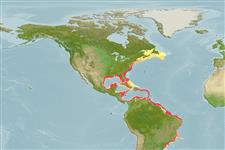Common names from other countries
Classification / Names / Names
Nomi Comuni | Sinonimi | Catalog of Fishes (gen., sp.) | ITIS | CoL | WoRMS
Environment: milieu / climate zone / depth range / distribution range
Ecologia
; distribuzione batimetrica 0 - 130 m (Ref. 103830), usually ? - 30 m (Ref. 103558). Tropical; 73°N - 28°S, 98°W - 33°W
Western Atlantic and the Arctic: Bermuda, Nova Scotia, from Chesapeake Bay to Florida Keys, Gulf of Mexico, Caribbean Sea to Brazil up to Santa Catarina.
Length at first maturity / Size / Peso / Age
Maturity: Lm ?, range 1 - ? cm Max length : 9.2 cm TL maschio/sesso non determinato; (Ref. 8); common length : 8.0 cm TL maschio/sesso non determinato; (Ref. 8)
Common total length: 6.0 to 8.0 cm (Ref. 8). This is an oceanic, demersal species found up to 130 meters in depth (Ref. 103831). Occurs in unconsolidated sublittoral sediments (Ref. 105332). Bottom sand or mud and shells (Ref. 8). Also found in seagrass (Ref. 102062). Preyed upon bony fishes (Refs. 34001, 105209, 105210). Known as a filter-feeder and zooplanktivore (Ref. 128410). In general, the majority of penaeids are omnivorous or detritus feeders (Ref. 105082).
Life cycle and mating behavior
Maturità | Riproduzione | Deposizione | Uova | Fecundity | Larve
Mating behavior: Precopulatory courtship ritual is common (through olfactory and tactile cues); usually indirect sperm transfer (Ref. 833). Spawning peaks during summer (Ref. 103558).
Holthuis, L.B. 1980. (Ref. 8)
IUCN Red List Status (Ref. 130435)
CITES status (Ref. 108899)
Not Evaluated
Not Evaluated
Human uses
Pesca: commerciale; Pesce da pesca sportiva: si
| FishSource |
Strumenti
Informazioni ulteriori
Age/SizeAccrescimentoLength-weightLength-lengthMorfologiaLarveAbbondanza
Fonti Internet
Estimates based on models
Preferred temperature
(Ref.
115969): 22.5 - 27.8, mean 24.8 (based on 256 cells).
Vulnerability
Low vulnerability (10 of 100).
